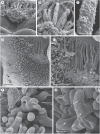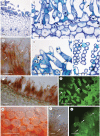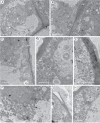Floral elaiophores in Lockhartia Hook. (Orchidaceae: Oncidiinae): their distribution, diversity and anatomy
- PMID: 24169595
- PMCID: PMC3838557
- DOI: 10.1093/aob/mct232
Floral elaiophores in Lockhartia Hook. (Orchidaceae: Oncidiinae): their distribution, diversity and anatomy
Abstract
Background and aims: A significant proportion of orchid species assigned to subtribe Oncidiinae produce floral oil as a food reward that attracts specialized bee pollinators. This oil is produced either by glabrous glands (epithelial elaiophores) or by tufts of secretory hairs (trichomal elaiophores). Although the structure of epithelial elaiophores in the Oncidiinae has been well documented, trichomal elaiophores are less common and have not received as much attention. Only trichomal elaiophores occur in the genus Lockhartia, and their distribution and structure are surveyed here for the first time.
Methods: Flowers of 16 species of Lockhartia were studied. The location of floral elaiophores was determined histochemically and their anatomical organization and mode of oil secretion was investigated by means of light microscopy, scanning electron microscopy and transmission electron microscopy.
Key results and conclusions: All species of Lockhartia investigated have trichomal elaiophores on the adaxial surface of the labellum. Histochemical tests revealed the presence of lipoidal substances within the labellar trichomes. However, the degree of oil production and the distribution of trichomes differed between the three major groups of species found within the genus. All trichomes were unicellular and, in some species, of two distinct sizes, the larger being either capitate or apically branched. The trichomal cuticle was lamellate, and often appeared distended due to the subcuticular accumulation of oil. The labellar trichomes of the three species examined using transmission electron microscopy contained dense, intensely staining cytoplasm with apically located vacuoles. Oil-laden secretory vesicles fused with the plasmalemma and discharged their contents. Oil eventually accumulated between the cell wall and cuticle of the trichome and contained electron-transparent profiles or droplets. This condition is considered unique to Lockhartia among those species of elaiophore-bearing Oncidiinae studied to date.
Keywords: Anatomy; Lockhartia; Oncidiinae; Orchidaceae; callus; elaiophore; oil secretion; trichomes.
Figures











Similar articles
-
Comparative anatomy of floral elaiophores in Vitekorchis Romowicz & Szlach., Cyrtochilum Kunth and a florally dimorphic species of Oncidium Sw. (Orchidaceae: Oncidiinae).Ann Bot. 2014 Jun;113(7):1155-73. doi: 10.1093/aob/mcu045. Epub 2014 Apr 15. Ann Bot. 2014. PMID: 24737719 Free PMC article.
-
Floral elaiophore structure in four representatives of the Ornithocephalus clade (Orchidaceae: Oncidiinae).Ann Bot. 2012 Sep;110(4):809-20. doi: 10.1093/aob/mcs158. Epub 2012 Jul 17. Ann Bot. 2012. PMID: 22805528 Free PMC article.
-
Comparative histology of floral elaiophores in the orchids Rudolfiella picta (Schltr.) Hoehne (Maxillariinae sensu lato) and Oncidium ornithorhynchum H.B.K. (Oncidiinae sensu lato).Ann Bot. 2009 Aug;104(2):221-34. doi: 10.1093/aob/mcp119. Epub 2009 May 15. Ann Bot. 2009. PMID: 19447811 Free PMC article.
-
Roles of synorganisation, zygomorphy and heterotopy in floral evolution: the gynostemium and labellum of orchids and other lilioid monocots.Biol Rev Camb Philos Soc. 2002 Aug;77(3):403-41. doi: 10.1017/s1464793102005936. Biol Rev Camb Philos Soc. 2002. PMID: 12227521 Review.
-
Mechanisms and evolution of deceptive pollination in orchids.Biol Rev Camb Philos Soc. 2006 May;81(2):219-35. doi: 10.1017/S1464793105006986. Biol Rev Camb Philos Soc. 2006. PMID: 16677433 Review.
Cited by
-
Comparative anatomy of floral elaiophores in Vitekorchis Romowicz & Szlach., Cyrtochilum Kunth and a florally dimorphic species of Oncidium Sw. (Orchidaceae: Oncidiinae).Ann Bot. 2014 Jun;113(7):1155-73. doi: 10.1093/aob/mcu045. Epub 2014 Apr 15. Ann Bot. 2014. PMID: 24737719 Free PMC article.
-
Centenary Progress on Orchidaceae Research: A Bibliometric Analysis.Genes (Basel). 2025 Mar 13;16(3):336. doi: 10.3390/genes16030336. Genes (Basel). 2025. PMID: 40149487 Free PMC article. Review.
-
Labellar anatomy and secretion in Bulbophyllum Thouars (Orchidaceae: Bulbophyllinae) sect. Racemosae Benth. & Hook. f.Ann Bot. 2014 Oct;114(5):889-911. doi: 10.1093/aob/mcu153. Epub 2014 Aug 13. Ann Bot. 2014. PMID: 25122654 Free PMC article.
-
Comparative survey of secretory structures and floral anatomy of Cohniella cepula and Cohniella jonesiana (Orchidaceae: Oncidiinae). New evidences of nectaries and osmophores in the genus.Protoplasma. 2019 May;256(3):703-720. doi: 10.1007/s00709-018-1330-1. Epub 2018 Nov 23. Protoplasma. 2019. PMID: 30470901
-
Nectar and oleiferous trichomes as floral attractants in Bulbophyllum saltatorium Lindl. (Orchidaceae).Protoplasma. 2018 Mar;255(2):565-574. doi: 10.1007/s00709-017-1170-4. Epub 2017 Sep 24. Protoplasma. 2018. PMID: 28944415 Free PMC article.
References
-
- Alves dos Santos I, Machado IC, Gaglianone MC. História natural das abelhas coletoras de óleo. Oecologia Brasiliensis. 2007;11:544–557.
-
- Brummitt RK, Powell CE. Authors of plant names. Kew, UK: Royal Botanical Gardens, Kew; 1992.
-
- Buchman SL. The ecology of oil flowers and their bees. Annual Review of Ecology and Systematics. 1987;18:343–369.
-
- Chase MW. A reappraisal of the oncidioid orchids. Systematic Botany. 1986;11:477–491.
Publication types
MeSH terms
Substances
LinkOut - more resources
Full Text Sources
Other Literature Sources

